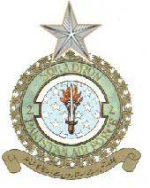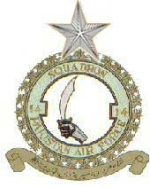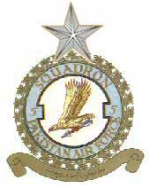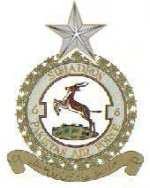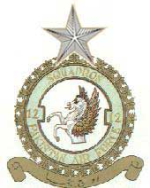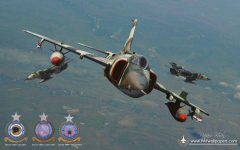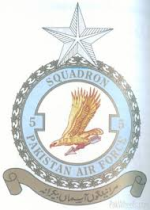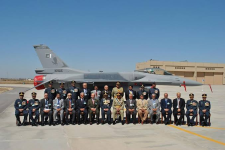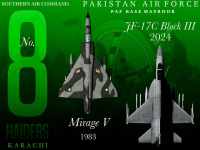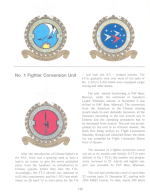No. 16 Squadron
The squadron was established in 1957, equipped with the F-86F Sabre, commanded by Squadron Leader Imam-ul-Haq Khan and assigned the role of Tactical Attack. Temporarily disbanded in 1963, the unit was re-established on 13 April 1970 at PAF Base Masroor flying the F-86F Sabre and commanded by Wing Commander Sharbat Ali Changazi.
In February 1971 the unit was assigned the role of training senior pilots in advanced tactics as the Fighter Leaders School. Although the squadron was not employed in the 1971 Indo-Pak War, its pilots were transferred to PAF Base Peshawar where they flew with the No. 26 Squadron. Wing Commander Changazi lead several strike missions into Indian territory and shot down an Indian Air Force Hawker Hunter. Squadron Leader Cecil Chaudhry, attached to the No. 18 Squadron, was shot down by ground fire but ejected safely and later shot down an Indian Sukhoi Su-7.[1]
In October 1972 the squadron was disbanded until 1982 when it was re-established at PAF Base Rafiqui and equipped with the Shenyang F-6. It was decided that the Panthers would be the first squadron to be re-equipped with the Nanchang A-5C attack fighter and personnel were sent to China to be trained on the type.
The first batch of A-5s was delivered to PAF Base Rafiqui on 12 February 1983, a re-equipment ceremony was held on 21 March 1983, the squadron was assigned the role of tactical attack and Wing Commander Hamid Saeed Khan was put in command. A Pakistan Day fly-past performance on 23 March 1983 earned the squadron a "Best Fly-Past" award. The Panthers also converted pilots of the No. 7 Bandits and No. 26 Black Spiders squadrons to fly the Nanchang A-5C. In November 1985 the unit began practicing with live 750 lb bombs and extensive Dissimilar Air Combat Training (DACT) with the PAF's F-16 squadrons.
In 1988 more DACT sorties were flown against the Chengdu F-7P. Five A-5C were added to the squadron's fleet in May 1989 and in mid-1990 Wing Commander Zafar carried out evaluations of the upgraded A-5M and A-5F attack fighters in China. In 1991 three Shenyang FT-6 dual seat fighters, with Martin-Baker ejection seats installed, were inducted for training purposes.
In November 1991 the unit was temporarily transferred to Multan and, while deployed there, flew 115 sorties with 100% serviceability and reliability rates. In 1997 was again temporarily transferred to PAF Base Mihas and Murid during runway re-carpeting at the unit's parent airbase. A deployment to PAF Base Chaklala for ADA (Air Defence Alert) duties was also carried out. In 1998 an A-5's canopy jettisoned during an Exercise Wide Awake sortie but the aircraft was landed safely
No. 16 Squadron (Pakistan Air Force)
The squadron was established in 1957, equipped with the F-86F Sabre, commanded by Squadron Leader Imam-ul-Haq Khan and assigned the role of Tactical Attack. Temporarily disbanded in 1963, the unit was re-established on 13 April 1970 at PAF Base Masroor flying the F-86F Sabre and commanded by Wing Commander Sharbat Ali Changazi.
In February 1971 the unit was assigned the role of training senior pilots in advanced tactics as the Fighter Leaders School. Although the squadron was not employed in the 1971 Indo-Pak War, its pilots were transferred to PAF Base Peshawar where they flew with the No. 26 Squadron. Wing Commander Changazi lead several strike missions into Indian territory and shot down an Indian Air Force Hawker Hunter. Squadron Leader Cecil Chaudhry, attached to the No. 18 Squadron, was shot down by ground fire but ejected safely and later shot down an Indian Sukhoi Su-7.[1]
In October 1972 the squadron was disbanded until 1982 when it was re-established at PAF Base Rafiqui and equipped with the Shenyang F-6. It was decided that the Panthers would be the first squadron to be re-equipped with the Nanchang A-5C attack fighter and personnel were sent to China to be trained on the type.
The first batch of A-5s was delivered to PAF Base Rafiqui on 12 February 1983, a re-equipment ceremony was held on 21 March 1983, the squadron was assigned the role of tactical attack and Wing Commander Hamid Saeed Khan was put in command. A Pakistan Day fly-past performance on 23 March 1983 earned the squadron a "Best Fly-Past" award. The Panthers also converted pilots of the No. 7 Bandits and No. 26 Black Spiders squadrons to fly the Nanchang A-5C. In November 1985 the unit began practicing with live 750 lb bombs and extensive Dissimilar Air Combat Training (DACT) with the PAF's F-16 squadrons.
In 1988 more DACT sorties were flown against the Chengdu F-7P. Five A-5C were added to the squadron's fleet in May 1989 and in mid-1990 Wing Commander Zafar carried out evaluations of the upgraded A-5M and A-5F attack fighters in China. In 1991 three Shenyang FT-6 dual seat fighters, with Martin-Baker ejection seats installed, were inducted for training purposes.
In November 1991 the unit was temporarily transferred to Multan and, while deployed there, flew 115 sorties with 100% serviceability and reliability rates. In 1997 was again temporarily transferred to PAF Base Mihas and Murid during runway re-carpeting at the unit's parent airbase. A deployment to PAF Base Chaklala for ADA (Air Defence Alert) duties was also carried out. In 1998 an A-5's canopy jettisoned during an Exercise Wide Awake sortie but the aircraft was landed safely




